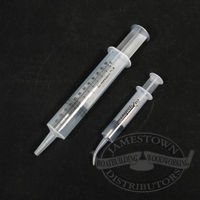Caleb, I've done these repairs several times on different boats. I always go back with Balsa on curved decks for, several reasons, It's cheaper than all materials, with it scored it will conform to the curve of the deck, it's what the factory used in the Pearson's I do. You can used the old decking skin but when you tape all the joints you will loose the factory non slip so I sand it all off and go back with non skid paint. Although my latest job I using KIWI-GRIP for nonskid.
If balsa is kept dry it will not fail. The factory never backfilled holes with epoxy and redrilled they just drilled a hole and bolted a fixture done with some sealer applied,this let water leak in and that killed the balsa.
I've used plywood on flat decked boats (fishing boats) and there is no problem if all through deck fittings are drill oversize ,filled with Epoxy and then drilled to the proper size. I use butyl tape to seal all through decks holes.
I don't use West products. I use supplies from FIBERGLASS COATINGS in FL they are on line. They beat everyone's prices and have everything you'll need for this job, plus tech support. They only sell to businesses so when you contact them have a business name ... like Caleb Boatworks, you don't need any more credentials than that. This work isn't that messy but taking the saw to the decks of your boat is a little unsettling, once you get over that, the job is very straight forward, I've chatted with folks who recored their decks with the boat in the water.
I don't own a moisture meter or vacum bagging system. I find soft spots , do some exploratory drilling to determine the size of the repair and go from there.
There are some little tricks I use like wetting out the balsa over a piece of PVC pipe so that epoxy leaches into the scoring to make little I beams of epoxy to help stiffen the area and help to stop water from spreading if a leak should occur again from failed sealer, but Butyl tape really never fails or drys out to allow a leak. I also drill holes through the deck skin to allow the excess epoxy to bleed out and allow the deck skin to settle into place. Two people would make this work go quickly but generally I work by myself.
I would be glad to offer any advice you may need over the phone. I'm just an amateur, hobby, boat restorer, but I have met with success with this type of work. A lot of this has been discussed on the Pearson Ariel website with plenty of pictures as well. You can reuse the deck skin but it's not worth the effort to try and save the factory nonskid.
If balsa is kept dry it will not fail. The factory never backfilled holes with epoxy and redrilled they just drilled a hole and bolted a fixture done with some sealer applied,this let water leak in and that killed the balsa.
I've used plywood on flat decked boats (fishing boats) and there is no problem if all through deck fittings are drill oversize ,filled with Epoxy and then drilled to the proper size. I use butyl tape to seal all through decks holes.
I don't use West products. I use supplies from FIBERGLASS COATINGS in FL they are on line. They beat everyone's prices and have everything you'll need for this job, plus tech support. They only sell to businesses so when you contact them have a business name ... like Caleb Boatworks, you don't need any more credentials than that. This work isn't that messy but taking the saw to the decks of your boat is a little unsettling, once you get over that, the job is very straight forward, I've chatted with folks who recored their decks with the boat in the water.
I don't own a moisture meter or vacum bagging system. I find soft spots , do some exploratory drilling to determine the size of the repair and go from there.
There are some little tricks I use like wetting out the balsa over a piece of PVC pipe so that epoxy leaches into the scoring to make little I beams of epoxy to help stiffen the area and help to stop water from spreading if a leak should occur again from failed sealer, but Butyl tape really never fails or drys out to allow a leak. I also drill holes through the deck skin to allow the excess epoxy to bleed out and allow the deck skin to settle into place. Two people would make this work go quickly but generally I work by myself.
I would be glad to offer any advice you may need over the phone. I'm just an amateur, hobby, boat restorer, but I have met with success with this type of work. A lot of this has been discussed on the Pearson Ariel website with plenty of pictures as well. You can reuse the deck skin but it's not worth the effort to try and save the factory nonskid.


Comment